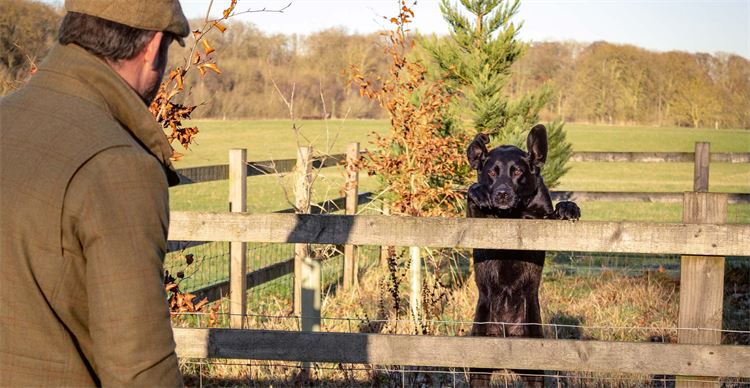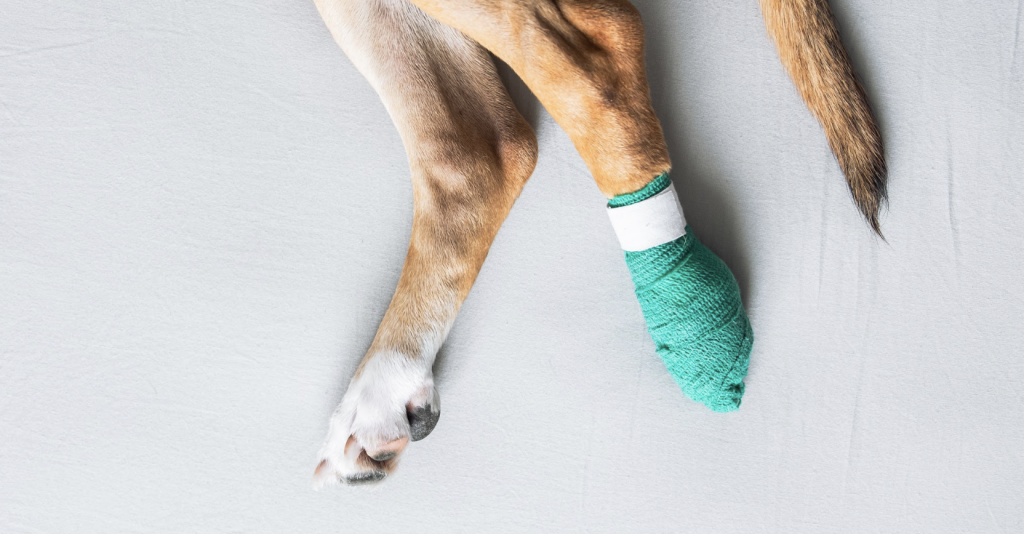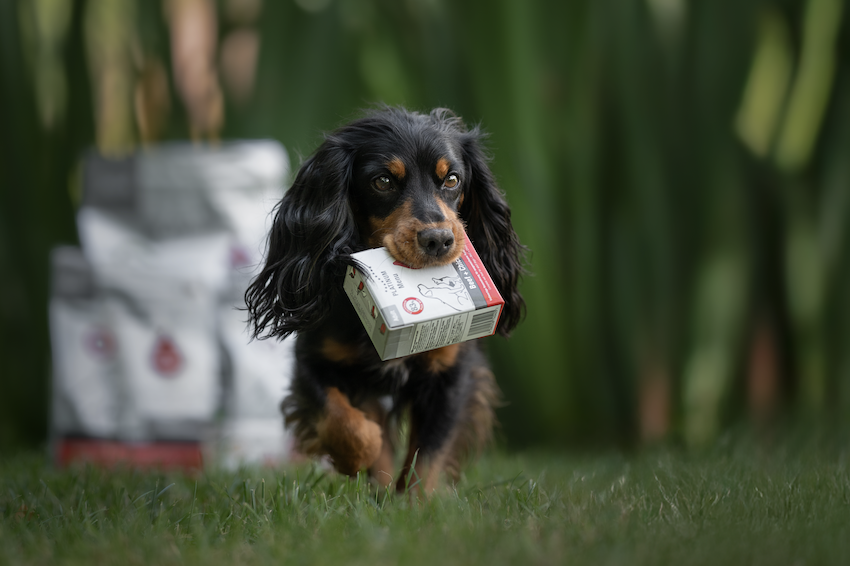7 Common Gundog Injuries to Look Out For
While most gundog owners can treat minor issues, some will require veterinary advice and attention. In this first of two articles, veterinary surgeon Laura Keyser shines a light on some common gundog injuries and how to deal with them.

Like all dog breeds, gundogs can suffer some common injuries and ailments. Whether these happen out in the field or simply due to the breed or age of your dog – there are a few key things you need to keep an eye on.
While most gundog owners can treat minor issues like superficial wounds even out in the field, there are some gundog injuries that will require veterinary advice and attention. In this blog post veterinary surgeon Laura Keyser shines a light on some common gundog injuries such as infection in dogs eye or limber tail, and how to deal with them.
1. Tail Tip Injuries in Beating Gundogs
Docked tail or not, gundogs trained for beating often charge through dense undergrowth and are at risk of damaging the end of their tails. Without careful management, tail tip injuries are unlikely to heal and can rapidly develop into chronic bleeding wounds. These cause pain and suffering for the dog, not to mention the blood splatters all over the walls and carpet as they wag enthusiastically when you return from work.
Avoiding tail tip injuries in an undocked dog can be difficult. Bandaging tails before going out for a shoot day is a trick that gundog owners often use, however, these bandages rarely stay on for long. Tail tip injuries should be treated promptly. Untreated trauma, or trauma that is not treated correctly, and skin infections can lead to:
- Chronic injuries
- Deep tissue infections
- Osteomyelitis
- Prolonged issues resulting in tail amputation
What should you look out for? If you notice a wound and your dog licking or chewing, intervene immediately. Whether you are in the field or at home, do your best to clean out the wound and wrap it in a clean cloth to prevent licking or biting until you visit your trusted veterinarian.
As well as prescribing antibiotics, pain relief, and a ‘cone of shame’, your vet will advise how best to provide protection while the tail tip heals. In the past, a protective solution was often fashioned out of syringe cases, bandages and foam insulation/lagging, but now there are specially designed mesh dressings that provide cushioning and aid healing.
2. Limber Tail in Working Dogs
Also known as ‘swimmer’s tail’ or ‘rudder tail’ this is technically called acute caudal myopathy and can cause a great deal of pain to your four-legged friend. Working dogs, especially those that have been overexerted and exposed to cold weather or very cold water within the last 24 hours, seem to be at the greatest risk.
What should you look out for? Typically the dog appears to have a limp tail drooping between their legs, or conversely, it may stick straight out behind them. This condition is often very painful, so they may be uncomfortable sitting or squatting to go to the toilet.
Diagnosis is usually based on the history and symptoms, but other conditions need to be ruled out including:
- Tail fractures
- Back or spinal pain
- Anal gland infections
- Prostate disease
Affected dogs usually recover fully within a few days to a week, with rest and non-steroidal anti-inflammatory drugs (NSAIDs).
3. Lameness
Lameness in dogs can be caused by anything from a cut pad or torn claw, to a strained muscle, cruciate ligament injury or fracture. Most lameness will improve with rest and anti-inflammatories, so keep an eye out for how your dog is progressing. If you notice marked or non-weight bearing lameness in your dog, this warrants veterinary attention.
Incomplete Ossification of the Humeral Condyles (IOHC) Lameness In Labradors and Spaniels
Unfortunately, our beloved spaniels and labradors, those most commonly out in the field, are prone to hereditary conditions such as Incomplete Ossification of the Humeral Condyles (IOHC) and hip or elbow dysplasia respectively. Kennel Club screening schemes aim to reduce the incidence, so it is advisable to buy from a reputable breeder who has hip and elbow scored their dam and sire.
Spaniels suffering from IOHC have been known to jump fences or out of game carts and fracture their elbow, with very little force. This is either because the elbow doesn’t fuse completely during development, or a stress fracture develops in adults, causing a fissure and therefore a weak point. Sadly, three of our family’s springers have suffered from this condition, resulting in catastrophic fractures, a lot of metalwork, and hefty vet’s bills. Thank goodness for pet insurance!
4. Hip Dysplasia, Most Commonly in Large Dog Breeds
Hip dysplasia is the most common cause of hind limb lameness in dogs and most frequently affects large breeds such as labradors. What is hip dysplasia? The hip is a ball and socket joint – In a dysplastic hip, the head of the femur fits loosely into a poorly developed, shallow cup. Joint instability occurs as skeletal growth exceeds muscle development, promoting abnormal wear and tear, cartilage erosion and pain, and eventually arthritis.
What to look out for? The most commonly recognised symptoms in young dogs between 6 and 12 months are:
- A bunny-hopping gait
- Difficulty getting up and down
- Limping or stiffness
- Exercise intolerance
Although hip dysplasia has a genetic component, there are a number of environmental factors that contribute. There are two factors that impact hip dysplasia the most and the work starts when your gundog is a puppy:
- Avoid feeding a high calorie or inappropriate diet to growing dogs and keep them lean and fit.
- Avoid excessive exercise during growth and discourage young dogs from jumping (such as over a fence) until fully matured.
Diagnosis relies on an accurate history, examination by your vet and X-rays under sedation/anaesthetic or CT/MRI. Conservative management includes non-steroidal anti-inflammatories (NSAIDs), additional pain relief, joint supplements such as omega-3, hydrotherapy or physiotherapy and weight control.
Severe cases can be treated surgically, with options including Total Hip Replacement (THR).
5. Osteoarthritis (Oa) In Dogs
Hip and elbow dysplasia can lead to osteoarthritis (OA). The condition causes long-term, irreversible degeneration of joints and affects the cartilage, bone and joint fluid. Many attribute changes in behaviour or activity to age or the amount of work the dog has undertaken. However, in most cases, your dog isn’t just ‘slowing down’. Arthritis is painful and your gundog’s quality of life can be dramatically improved with pain relief.
What are key signs of Osteoarthritis? You will notice stiffness, lameness and pain, often more evident after a period of rest or a day’s work.
6. Wounds
Barbed wire, dog fight or muntjac attack, whatever the cause, deep wounds need veterinary attention. Cut pads and broken nails are also very common injuries in gundogs. Wounds are likely to be contaminated with mud and bacteria which is why immediate attention is crucial.
If you are out in the field when you notice wounds on your gundog, try to flush them thoroughly with clean water, to physically remove the dirt. Once clean, cover the wound with a sterile dressing if available. It’s worth having a dog first aid kit in the car but in an emergency, a makeshift dressing such as a handkerchief or gun cleaning cloth would suffice.
Superficial wounds may heal with cleaning, dressings and medication. Deeper wounds may need stitching under sedation/anaesthetic, allowing the best outcome, the neatest cosmetic appearance and fastest return to work. It is also important to know that wounds can break down and may not heal the first time, so the dog may be off work for more than two weeks.
Whenever possible, try to avoid your dog jumping over barbed wire by lifting them or laying a coat sleeve over the fence before they leap. I’ve seen enough penile, scrotal and inguinal lacerations to make anyone’s eyes water…
7. Eye Problems in Dogs: Ulcers and Redness
Eye injuries should always be considered an emergency. You may have been unaware of an injury to your dog’s eye occurring, but may notice:
- Squinting
- Trying to rub or paw at their face
- Appear light-sensitive
- The eye may have a red or cloudy appearance, with an ocular discharge and a small pupil
Eye trauma is notoriously painful. Penetrating injuries, such as a thorn in the eye, must be treated with great caution and only removed by a vet. Never try to pull out a foreign body.
If there is no visible foreign body, your Vet will need to assess the severity of a corneal wound by applying a special dye called fluorescein. This turns green in the eye, adhering to and highlighting areas of ulceration.
Small or shallow corneal abrasions will be treated with antibiotic drops, painkillers and atropine drops to relieve spasms and pain. If not responding to treatment, your vet may need to debride any poorly healing areas of the cornea and perform a grid keratectomy (small scratches on the eye’s surface to promote healing), apply a contact lens or temporarily suture the eyelids closed, or perform a corneal graft.
Deeper ulcers eroding the cornea down to the bottom layer are very serious. If not treated aggressively, liquid from within the eye can leak causing the eyeball to collapse and irreparable damage occurs. This eye would then need enucleating (removing).
Taking Care of Your Gundog
Looking after working and active dogs is a full-time job. Our beloved four-legged friends are eager to find, catch, and retrieve without thinking about scratches or injuries. As recommended, always have a little gundog first aid kit on you to make sure you can attend to your dog in case an injury happens out in the field.
Keeping a small diary of any behavioural changes in activity, feeding, or walking may also prove useful – especially if you suspect a bigger culprit such as limber tail or hip dysplasia in your dog.
We hope Laura’s advice has proved helpful, for more about dog health and tips on keeping your gundog in top shape take a look at more of our gundog Health articles.
Related Articles
Get the latest news delivered direct to your door
Subscribe to Gundog Journal
Unlock the full potential of your working dog with a subscription to Gundog Journal, the UK’s only dedicated magazine for gundog enthusiasts. Published bi-monthly, this authoritative resource delivers expert training advice, in-depth interviews with top trainers and veterinary guidance to help you nurture a stronger bond with your dog.
With stunning photography and thought-provoking content, Gundog Journal is your essential guide to understanding, training and celebrating your working dog.
Save 10% on shop price when you subscribe, with a choice of packages that work for you. Choose from Print & Digital or Digital only with each journal delivered directly to your door or via the app every other month, plus access to past issues with the digital back issue library.








